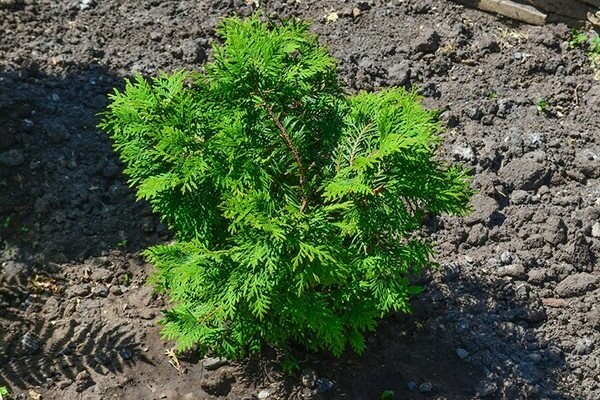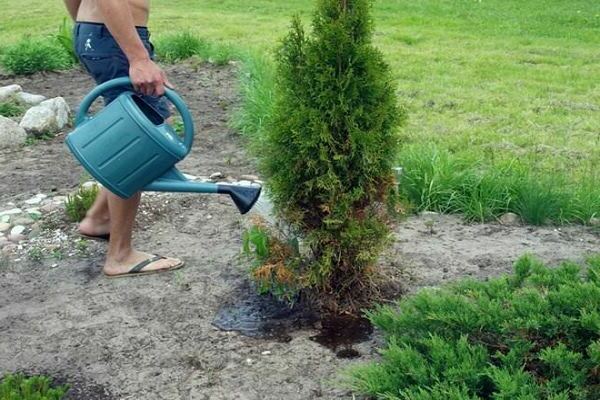Thuja care
Content:
Having planted a thuja in your summer cottage, you definitely did not lose. This evergreen plant of the Cypress family will delight you with its appearance for many years. This is not to say that thuja is capricious and requires a lot of attention. But if you want your plant to remain green, not turn yellow or blacken, then you will have to devote time to it and familiarize yourself with the rules of care. Knowing when it is best to plant thuja, what care is needed after planting and at different times of the year, you will help the plant stay healthy and maintain an attractive appearance.
Thuja care for the first time after planting

thuja care
The time you choose for planting determines the further care of the plant. Timely planting, the right place are the most important factors that determine the further state of health of the plant, and therefore your actions.
If you planted a thuja in spring or summer time, then most of all she will need weekly watering. This is if the weather is normal, not hot. In hot and sunny weather, water it twice a week. But keep in mind that experts do not recommend replanting plants in the heat, since in this case they do not take root well.
When watering, the plant should receive at least ten liters. In case of extreme heat and large plant sizes - twenty liters per watering. The larger the plant, the more liquid it needs.
In the first three to four weeks, in addition to watering at the root, it is necessary to periodically carry out sprinkling... At the same time, the pores open, the plant breathes, and you will be able to catch a light coniferous aroma. Thuja needles consist of scales. It evaporates water quickly, so it needs regular make-up.
Sprinkling is sufficient once a week in normal weather. But in case of extreme heat, you need to do this daily. The ideal time for this procedure would be evening hours or early morning (4-5 am).
If you planted a thuja in autumn time, she also needs a sufficient amount of moisture, which means watering and sprinkling. But since autumn is the rainy season of the year, then, first of all, build on the weather conditions.
If it hasn't rained for a week, water it. If it rains regularly, then you can completely refuse watering. In this case, on the contrary, it is necessary to ensure that there is no waterlogging, which can lead to the development of diseases.
At the first time after planting, it is not necessary to apply fertilizers, since the plant will have enough of those that it received during planting. If at the time of planting you did not take into account this moment and forgot about fertilizers, then in the spring or summer time you need to feed.
In autumn, this is not necessary, since top dressing will stimulate the development of young shoots, which will not have time to get stronger before winter and will freeze. After planting, regardless of the season, you can use growth stimulants... They will help the early rooting and adaptation of the plant.
The ideal option would be to use the drug "Zircon". In addition to stimulating the growth of the root system, it has fungicidal and antimicrobial properties. This means that it will have a positive effect on the immunity of your thuja.
Thuja care outdoors throughout the year

thuja care
On the one hand, conifers are one of the least demanding plants. On the other hand, it happens that thuja after the winter months dried up, or darkened, or turned yellow after an incorrect transplant. So thuja care is necessary throughout the year. Only in the winter months can you rest while your thujas are sheltered from frost.
But as soon as winter recedes, with the arrival of spring, it's time to pay attention to the plants. Wait until the snow melts and the ground around the thuja begins to warm up, only then can the shelter be removed.
If you do this too early, the young twigs will start growing actively under the influence of the warm spring sun. And since the roots will be in the frozen ground, the water balance will be disturbed and your thuja will turn yellow.
If the thuja nevertheless turned yellow after the winter period, then, first of all, one should try to determine the reason why this happened, and depending on it, solve the problem.
Thuja home care: causes of yellowing of the plant
- Thuja could get burned. And as a result, you got this "tan" - yellow and drying twigs. To avoid this, it is necessary to take care of shading the plant back in February. To do this, wrap it up with gauze or mosquito netting. Such material will not interfere with air circulation, but at the same time will protect against ultraviolet rays. It is important to remember that spandbond is not suitable for this purpose, as it transmits ultraviolet rays. If you didn’t manage to cover the thuja from the sun, then in the spring water them with warm water and spray them with the “Ecoel-Antistress” preparation. It is a biostimulant, it accelerates plant growth. And with the onset of summer, carefully cut off all affected branches.
- Stagnant water can be another reason for the yellowing of thuja. Closely located groundwater, prolonged rains can lead to sticking of the roots and not only yellowing, but also the appearance of mold. If it was in the rains, then loosen the soil in the near-trunk circle so that the moisture evaporates actively. Cut off the affected branches with pruning shears and treat the soil with an antifungal agent so that it gets on the roots. The crown can be sprayed with a growth stimulant. If the problem is in the groundwater, then the only option is to transplant the plant to a drier place and this time to provide it with good drainage.
- Harmful insects or diseases can also cause discoloration and drying. As soon as you remove the plants from the shelters, you should conduct regular inspections for pests or signs of disease. Spread the branches apart, remove all plant debris, which are often the main source of problems. They hide the larvae of parasites. If yellowish ulcers appear, it means that a thuja false shield lives on your plant. In this case, you can use any of their drugs: "Actellik", "Rogor", "Oxyhom".
Thuja care - preventive measures

In early spring, you can carry out preventive treatment with Bordeaux liquid. If done on time, many problems can be avoided. If the thuja twigs darken, even turn black after the winter months, then a fungal infection is most likely spread.
We'll have to carry out sanitary pruning and treat the plant with "Hom" in two steps. Spill the soil around the plant with a solution of the drug "Fundazol".
The second reason for the darkening of the branches can be your pets. Observe the dogs, if they mark the thuja, then the reason is most likely this. Shield the plant from them and spray it with any fungicide.
It is necessary to feed the thuja in the spring and summer. After mid-August, fertilization is not advisable. As a top dressing, you can use specialized formulations "Osmokot", "Kemira-Universal".
Watering during spring, summer and autumn should be the same as after planting the plant (we talked about this above), but of course taking into account the weather and precipitation.
For the winter, you can insulate plants using geotextiles. But do not forget to change it to a mosquito net at the end of winter to protect the plants from burns.
Conclusion
As you can see, there is nothing difficult in caring for thuja. The main points are to choose a good place for the plant and to achieve the right balance with watering.Carry out preventive treatments for diseases and harmful insects, as well as shade the plants in the spring and cover them for the winter. Then your thuja will remain fluffy and green.

